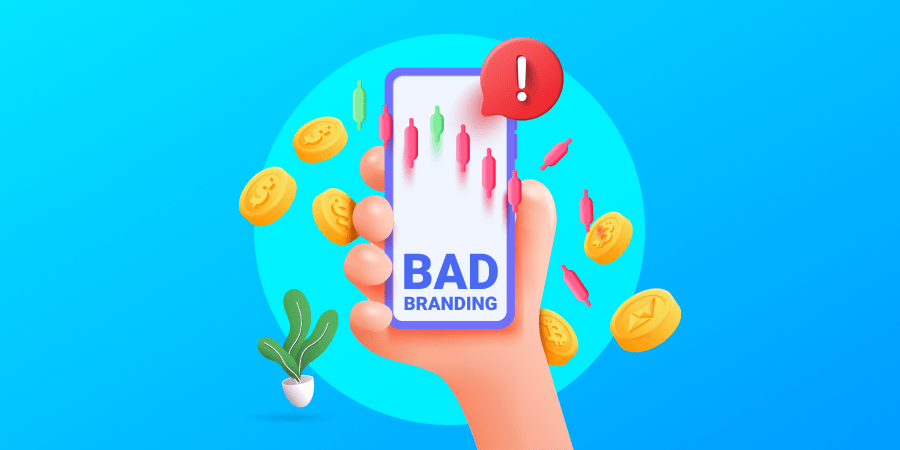From iconic logos and catchy taglines to memorable customer experiences (we’re looking at you, Chick-Fil-A!), brand recognition is the key to product or service differentiation, as well as consumer trust and loyalty.
We’ll explain the different stages of brand recognition and share leading strategies to help you build a recognizable brand. Plus, we’ll explore examples from top brands around the world.
[ez-toc]
Digital Silk develops authentic brands. Request A Quote
What Is Brand Recognition?
Brand recognition is the extent to which consumers can accurately identify a brand, associate it with its products, services or reputation and differentiate it from other brands on the market.
Brand recognition is established through strong associations between a brand’s visual (and sometimes audio) elements, such as logos, colors and packaging and the brand itself.
The idea is that when consumers consistently encounter these visual or audio cues in various contexts, they become familiar with them and can quickly identify and differentiate the brand from others.
Brand Recognition vs. Brand Awareness
While brand recognition refers to the ability of consumers to recognize and identify a brand, brand awareness is a broader concept that encompasses both recognition and a deeper understanding of the brand.
Because these are both branding terms and important elements of building a brand, brand recognition and brand awareness are often confused.
Brand recognition is a component of brand awareness, as the first step a brand strives to achieve towards building awareness and developing a strong brand presence in the minds of consumers.
Brand recognition is also related to brand equity, as it contributes to the overall value and perception of the brand.
Brand awareness, in contrast, is a more in-depth understanding of what a brand represents in addition to what it sells, including its values, attributes and reputation.
5 Stages Of Brand Recognition
Brand recognition is not achieved through a single act. It involves several distinct stages that continuously solidify a brand’s presence in the minds of consumers.
While a brand is engaged in marketing, advertising and similar efforts to help establish recognition, a consumer is unknowingly moving through the following five stages.
1. Brand Awareness
This stage is the initial awareness of a brand among its target audience.
To facilitate awareness, a brand focuses on increasing visibility through various marketing and advertising channels to ensure that consumers recognize the brand’s existence and associate it with the specific products or services it offers.
2. Brand Preference
Once consumers are aware of a brand, the next step is to position the brand as a favorable choice among competitors.
In this stage, a brand works to emphasize their unique selling proposition, showcase how their products or services can benefit consumers and deliver exceptional customer experiences.
3. Brand Reputation
Brand reputation includes the overall perception of a brand among consumers and the public, with a focus on product quality, customer service, brand values and ethical practices.
To facilitate this stage, a brand focuses on delivering on brand promises, addressing customer feedback and maintaining transparency and integrity in business operations.
4. Brand Trust
Trust is a crucial stage in brand recognition. To build trust among consumers, a brand needs to present itself as reliable and credible.
To do this, a brand focuses on open communication, positive experiences and responsible behavior— all of which help facilitate long-term relationships with customers.
5. Brand Loyalty
Brand loyalty is the ultimate stage of brand recognition. It occurs when a deep and emotional connection between the brand and its customers is established.
Brand loyalty is achieved by meeting or exceeding customer expectations, offering unique value and fostering a sense of belonging.
When consumers become loyal to a brand, they continue to choose the brand and act as its advocates, recommending it to others.
This is incredibly valuable to a brand, not only because it offers free marketing, but because loyal consumers are repeat customers — often for a long period of time.
Let’s grow your brand online! Set up a consultation
The Importance Of Brand Recognition
Simply put, a brand cannot survive or thrive without brand recognition.
Brand recognition:
- Differentiates a brand: Recognition helps a brand stand out from its competitors, as each stage offers the brand an opportunity to define their unique value.
- Offers expansion opportunities: Consumers who are familiar with and trust a brand are more willing to try new offerings from the same brand, facilitating growth and expansion opportunities. For example. If a non-toxic makeup brand that consumers perceive well is looking to expand, they may choose to release a non-toxic fragrance. With a high level of brand recognition (i.e. trust), the fragrance is more likely to be successful
- Provides a competitive advantage: Brands with high recognition levels typically enjoy a leading market position and customer preference.
- Increases loyal, long-term customers: Brand recognition establishes an emotional connection and trust with consumers, which fosters a sense of loyalty and deeper engagement, creating a strong bond that encourages long-term customer relationships.
- Boosts pricing power: Brands with high recognition levels can often charge premium pricing for their products or services since consumers are willing to pay more for brands they recognize. In fact, a recent study found that 71% of consumers are inclined to shop from a brand they recognize.
Top Brand Recognition Examples Across Industries
At Digital Silk, we love to present examples. Here’s a look at some of our favorite brand recognition examples from companies you’re sure to know!
1. McDonald’s
The iconic golden arches of the McDonald’s logo are widely recognized — to the point where you might even be able to taste the salty fries or juicy McDouble with just a glimpse of the logo.
McDonald’s has been able to reach widespread brand recognition through catchy slogans, such as “I’m Lovin’ It,” well-known characters like Ronald McDonald, in addition to UVPs like affordability, convenience and a sense of familiarity.
In the company’s “Raise your arches” campaign, a group of office colleagues conspired to go to a McDonald’s restaurant without sharing a single word.
Despite not featuring any McDonald’s branding or food, the campaign was able to establish brand recognition and connect with consumers, reinforcing McDonald’s as a familiar and enjoyable destination.
2. Coca-Cola
From that famous red color to the distinct script font and the shape of the bottle itself, the Coca-Cola brand is instantly identifiable, making it one of the most loved and globally recognized brands in the world.
Since its creation, Coca-Cola has become synonymous with refreshing beverages and timeless branding, fostering a sense of happiness, togetherness, nostalgia and inspiration.
Coca-Cola’s campaigns aim to celebrate the individuality of each consumer and transform ordinary moments into extraordinary ones, through the power of the beverage itself.
In the brand’s “Masterpiece” campaign, Coca-Cola inspires people to find joy in everyday moments and embrace their own “masterpiece” of happiness, while creating memorable experiences with Coca-Cola.
3. Nike
Nike‘s brand recognition is deeply rooted in its famous Swoosh logo, its association with a variety of sports and its inspirational message of “Just Do It.”
In what has become a symbol of performance, innovation, motivation and empowerment, Nike has strengthened its logo recognition (and brand recognition) through powerful marketing campaigns and partnerships with top athletes, such as Serena Williams, Lebron James and Michael Jordan.
The Nike “Unlimited Future” campaign features the company’s sports ambassadors as babies and conveys a message about the potential and possibilities that lie within every individual from an early age.
It’s this message of hope and possibility that sends consumers around the world flocking to the Nike brand.
4. Amazon
The world’s largest online retailer is no stranger to consumers, regardless of their age or location. Amazon’s logo is a yellow arrow that sits underneath the Amazon “a” — reminiscent of a happy smile and of course, a happy customer.
Amazon’s branding approach is to play on consumer emotions, tugging at the heartstrings of many and enticing them to become loyal shoppers.
One of the company’s popular commercials, “Saving Sawyer,” features a mischievous dog causing chaos in the house while the owners are away. The family then decides to do some Amazon shopping — and a crate purchase ends up with an unexpected twist.
5. Apple
This brand’s bitten Apple logo is instantly recognizable around the world and prompts an immediate consumer association with Apple’s innovative products — the iPhone, MacBook, iPad and Apple Watch, to name a few.
Apple’s marketing campaigns, with slogans like “Think Different” and “Apple at Work,” position the brand as a symbol of creativity and premium quality.
In a marketing campaign titled “The Underdogs,” a team of employees is tasked with creating a presentation for their boss. The team faces various obstacles, from technology malfunctions to tight deadlines, but they use Apple products and services to overcome the challenges and deliver an impressive outcome.
The film highlights the power of Apple technology in supporting creativity, team collaboration and productivity, emphasizing how Apple can empower both individuals and teams to achieve their goals.
With their simple yet impactful branding and a promise of high-quality products that they consistently deliver, Apple is taking over the world one consumer at a time.
How To Build Brand Recognition
Brand recognition isn’t achieved in one simple step and it doesn’t happen overnight. However, with the right strategies in place, you can set your brand up for visibility, recognition and trust to ultimately gain loyal consumers.
1. Define Your Brand Identity
The first step is to firmly define your brand identity, including its values, mission, target audience and unique selling proposition. This step lays the foundation for consistent brand messaging and visual elements.
2. Create Consistent Brand Messaging
Craft clear and compelling brand messaging that communicates your brand’s value proposition, benefits and unique selling points to convey to your target audience.
3. Develop A Strong Visual Identity
Create a distinctive visual identity, including a unique logo, consistent color palette, typography and other visual elements that reflect your brand’s personality and resonate with your target market.
4. Build An Online Presence
Establish a visible online presence through professional website design and active engagement on relevant social media platforms. Use SEO web design to increase your visibility and traffic.
5. Remain Consistent Across Touchpoints
Ensure consistency across all touchpoints, including your website, packaging, marketing materials, social media profiles and advertising campaigns.
While branding, marketing and language may be tweaked depending on the platform, your brand’s visual identity and message should be the same on all channels. A consistent presence will help you strengthen your brand recognition.
6. Focus On Content Marketing
Develop a content marketing strategy that aligns with your brand values and resonates with your target audience. Create relevant, specific and engaging content across various channels to reinforce your brand’s expertise.
This will help position your brand as a thought leader and an expert in your field, which will help you build trust among consumers.
7. Engage With Your Audience
Engage with your audience on social media platforms, respond to customer inquiries and provide prompt feedback, fostering meaningful conversations. Building a strong connection with your audience enhances your brand reputation, which in turn increases trust and loyalty.
8. Participate In Sponsorships & Partnerships
Explore the possibilities of strategic brand collaborations and join efforts with other brands or influencers to expose your brand to new audiences and enhance recognition in new or wider markets.
9. Monitor & Adapt
Monitor and analyze the effectiveness of your brand recognition efforts. Track metrics such as website traffic, social media engagement, customer feedback and brand sentiment.
Based on the insights received, continuously evaluate and optimize your strategies to ensure that you’re reaching your target consumer, accurately conveying the benefits of your service or product and connecting with your target market.
Grow Your Brand Recognition & Build A Brand Strategy With Digital Silk
At Digital Silk, we understand the power of a recognizable and trusted brand in all industries.
Our full-service branding agency specializes in helping business owners like you establish a prominent presence, grow your visibility within your target market and nurture your audience to become loyal brand advocates.
At Digital Silk, our branding deliverables include:
- A comprehensive brand audit: Our team will assess your company’s brand identity, messaging, positioning, online presence and marketing strategies to identify areas of strengths, weaknesses and opportunities for improvement.
- A unique visual identity: From crafting a remarkable logo and choosing a color palette to designing eye-catching graphics and compelling visuals, our talented designers will work closely with you to create a captivating visual identity that resonates with your target audience.
- A compelling brand story: Our skilled copywriters will collaborate with you to develop an engaging brand narrative that authentically represents your values, mission and vision.
- Brand messaging and positioning: We’ll work closely with you to craft a clear brand message that resonates with your target audience and conveys your unique value proposition.
- Brand monitoring and analytics: We will monitor, measure and analyze performance, and based on the insights received, will refine and optimize strategies to continuously enhance your brand visibility and recognition.
As a full-service web design agency, we also offer web design and development, digital marketing, consulting services and more.
Schedule a consultation to meet our team and find out what we can do for your brand.
Tell us about your branding project. Request a proposal.
"*" indicates required fields








